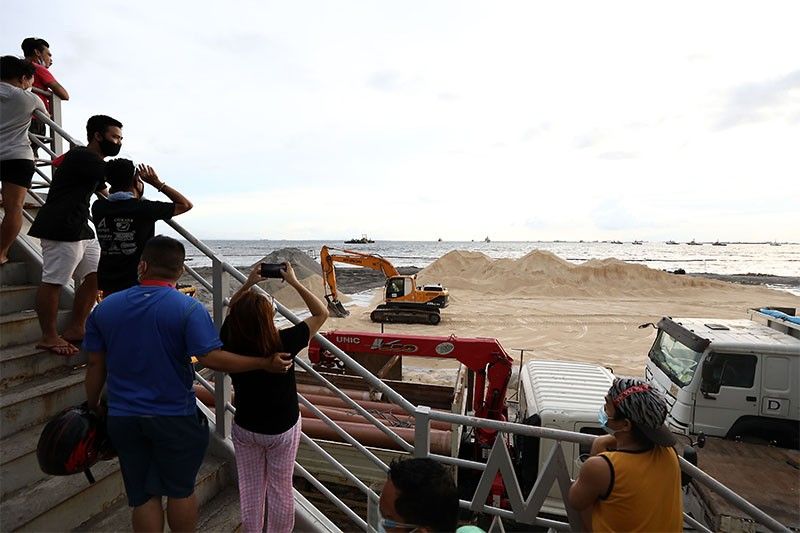Groups call for halt to 'ill-conceived' Manila Bay 'white sand' project

MANILA, Philippines — The government’s project to build an artificial "white sand" beach on the shore of Manila Bay should stop as it violates at least five environmental and cultural laws, groups opposing the “beach nourishment” project said.
In a position paper Tuesday, fishers and environmental groups said they are alarmed that the P389-million Manila Bay beautification is being implemented allegedly without compliance with national laws.
The government began filling a stretch of Manila Bay’s rocky shore last week with artificial sand made from crushed dolomite rocks as part of its program to rehabilitate the degraded body of water, earning criticism from organizations saying it may potentially harm the marine ecosystem and communities.
“We condemn the project and it must be stopped as it has not undergone an environmental impact assessment nor a consultative and participatory process in both Manila Bay and in Cebu, as to its environmental impacts, thereby violating several environmental laws,” the groups said.
Environmental Impact Statement system
The groups pointed out that the “ill-conceived” project should have gone through the Environmental Impact Statement (EIS) system like other projects or undertakings which are seen to have a significant adverse impact to the quality of the environment.
“No person may undertake environmentally critical projects or any project in environmentally critical areas without an environmental compliance certificate,” they said.
Department of Environment and Natural Resources Undersecretary Benny Antiporda earlier said the project is not covered by the EIS system and only a certificate of non-coverage, which is issued for undertakings that are deemed unlikely to cause significant adverse impacts on the environment, was secured.
The Fisheries Code also prohibits aquatic pollution, which is defined as anything introduced to bodies of water that can harm living and non-living marine resources or humans. Depositing of any materials into bodies of water or their margins that cause water pollution is also not allowed under the Clean Water Act.
Historical landmark
The organizations also stressed that the National Cultural Heritage Act of 2009 prohibits the alteration of Manila Bay’s original features.
“Mania Bay waterfront was declared a National Historical Landmark by the National Historical Commission of the Philippines in 2012. It is protected by the National Cultural Heritage Act of 2009. The act mandates that the bay ‘shall be maintained as close to their appearance at the time the area was most of importance to Philippine history as determined by the National Historical Institute,'” they said.
The groups also slammed the lack of consultation with the city of Manila, which violates the Local Government Code of 1991.
“The project cannot proceed without consultation with and prior approval of the Sangguniang Bayan of Manila,” they said.
Antiporda earlier said no public consultation was needed because it was only a “beach nourishment” project.
A source familiar with the project told Philstar.com that the DENR defines “beach nourishment” as an “adaptation technology primarily used in response to shoreline erosion, although flood reduction benefits may also occur.”
Rising sea level, erosion
The government’s plan is to fill a portion of Manila Bay with artificial white sand at one-meter thick.
“We cannot gloss over the fact that sea level rise will lay to waste the funds expended for this beautification project,” the groups said, citing a study of the National Mapping and Resource Information Authority that sea level is rising four times faster than the global average of 3.2 millimeters a year in the Manila Bay area.
They also said periodic maintenance of the beach and replenishment of huge amounts of dolomite are expected given that the coast along Roxas Boulevard is constantly subject to strong waves, storm surges and flooding.
A DENR source also said having a “nourished” beach will prevent erosion “by dissipating wave energy and having a balanced sediment budget.”
Geotextile tubes filled with sand have been also installed on the beach the source said, which would act as a breakwater and will allow water to pass through while preventing the filling material from being washed away.
According to the groups which include Oceana, Living Laudato Si Philippines and the Archdiocese of Manila-Ministry of Ecology, the dumping of artificial white sand could also lead to aquatic pollution, marine habitat degradation, loss of globally important waterbird site, loss of sardine spawning grounds and loss of mangroves and wetland areas.
“The dumping of crushed dolomite boulders in Manila Bay can only be described as an abdication of that grave responsibility to protect and preserve Manila Bay. This is happening at the time when our nation faces serious health, economic and climate crises,” they said.
In a separate statement, fishers group PAMALAKAYA said the “beach nourishment” project was not in compliance Supreme Court mandamus on Manila Bay. The mandamus, issued on 2008, directed agencies to clean up and rehabilitate Manila Bay and restore its waters for recreational use and fishery resources development.
Focus on ecological degradation
The groups stressed that the dumping of “white sand” should be halted and the government behind the project should be held accountable.
“That this is the brainchild of DENR, whose very mandate is to protect the environment and enforce environmental laws, erodes trust in our institutions which are mandated to protect our environmental rights,” they said.
Instead of turning to beautification, authorities should reduce pollution on the bay, ban the cutting of mangroves and stop conversion of mangrove areas and wetlands through reclamation projects and improve the management of protected areas.
They also called for the establishment of the Fisheries Management Area for a science-based decision making on fisheries management.
The position paper will be sent to the DENR, the Department of Agriculture, the Bureau of Fisheries and Aquatic Resources, both legislative chambers, Office of the Ombudsman, the office of Mayor Isko Moreno and the National Historical Commission of the Philippines.
- Latest
- Trending

































